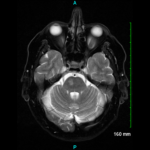“There are many similarities between these conditions, and one could think that they belong not only to the same family but possibly to the same syndrome,” he said.
A recent study attempted to pinpoint differences between large-vessel GCA (LV-GCA) and classic GCA (C-GCA). Researchers found that those with LV-GCA tended to be younger, with a longer period of symptoms before being diagnosed and more commonly had a history of polymyalgia rheumatica, but a smaller number of them had cranial symptoms. Patients with LV-GCA had a lower rate of blindness but a higher relapse rate and greater steroid doses, researchers found.6
New large-vessel vasculitis biomarkers, which could help with identification and management of the disease, have emerged over the past few years, including pentraxin-3, which has shown high specificity compared to controls and has even shown some ability to differentiate between active disease and disease in remission.7
Promising data have also been generated on antiferritin antibodies and antibodies to the 14-3-3 aorta protein, the newest biomarker candidate, which has been seen frequently in patients with different types of LVV and not often seen in controls, Dr. Cimmino said.8,9
But these biomarkers, he said, “should be studied in the long term to evaluate their prognostic [value].”
Thomas R. Collins is a freelance medical writer based in Florida.
References
- Durand M, Thomas SL. Incidence of infections in patients with giant cell arteritis: A cohort study. Arthritis Care Res (Hoboken). 2012 Apr;64(4):581–588.
- Mekinian A, Comarmond C, Resche-Rigon M, et al. Efficacy of biological-targeted treatments in Takayasu arteritis: Multicenter, retrospective study of 49 patients. Circulation. 2015 Nov 3;132(18):1693–700.
- Goel R, Danda D, Kumar S, et al. Rapid control of disease activity by tocilizumab in 10 ‘difficult-to-treat’ cases of Takayasu arteritis. Int J Rheum Dis. 2013 Dec;16(6):754–761.
- Villiger PM, Adler S, Kuchen S, et al. Tocilizumab for induction and maintenance of remission in giant cell arteritis: A phase 2, randomised, double-blind, placebo-controlled trial. Lancet. 2016 May 7;387(10031):1921–1927.
- Langford C, Cuthbertson D, Ytterberg S, et al. A Randomized Double-Blind Trial of Abatacept and Glucocorticoids for the Treatment of Giant Cell Arteritis. Abstract 9L. Presented Nov. 10, 2015. American College of Rheumatology Annual Meeting. San Francisco.
- Muratore F, Kermani TA, Crowson CS, et al. Large-vessel giant cell arteritis: A cohort study. Rheumatology (Oxford). 2015 Mar;54(3):463–470.
- Ishihara T, Haraguchi G, Kamiishi T, et al. Sensitive assessment of activity of Takayasu’s arteritis by pentraxin3, a new biomarker. J Am Coll Cardiol. 2011 Apr 19;57(16):1712–1713.
- Baerlecken NT, Linnemann A, Gross WL, et al. Association of ferritin autoantibodies with giant cell arteritis/polymyalgia rheumatica. Ann Rheum Dis. 2012 Jun;71(6):943–947.
- Chakravarti R, Gupta K, Swain M, et al. 14-3-3 in thoracic aortic aneurysms: Identification of a novel autoantigen in large vessel vasculitis. Arthritis Rheumatol. 2015 Jul;67(7):1913–1921.

